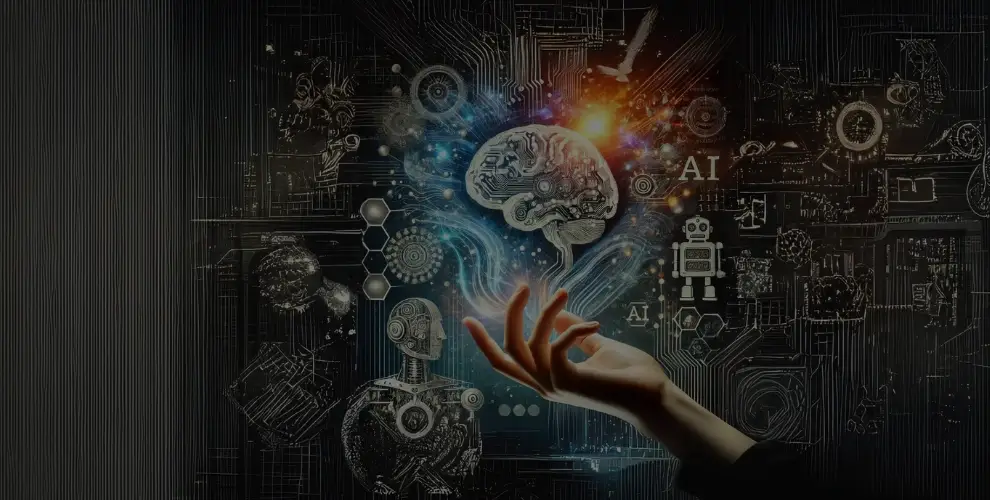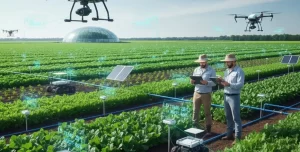
Who Created Artificial Intelligence? A Comprehensive History of AI Development
Table of Contents
Introduction
Welcome to WikiGlitz!
In today’s blog, we explore the intriguing question: Who created artificial intelligence?
Let’s dive deep into the history and evolution of AI, discussing the key figures, milestones, and technological breakthroughs that shaped this groundbreaking technology.
Artificial Intelligence (AI) has revolutionized how we interact with technology today, from self-driving cars to personal assistants like Siri and Alexa.
Understanding who created artificial intelligence involves exploring the contributions of multiple individuals and key moments in AI development.
Key Takeaways
- Artificial intelligence was created by a collective effort of pioneering researchers, not just one individual.
- The term “Artificial Intelligence” was coined in 1956 by John McCarthy, a key figure in the field.
- AI’s evolution has been shaped by advancements in computing, influential researchers, and practical applications across various industries.
Who is the Father of Artificial Intelligence?
The title of the father of artificial intelligence is often attributed to John McCarthy, a computer scientist who played a pivotal role in defining the field.
In 1956, McCarthy organized the famous Dartmouth Conference, where he coined the term “Artificial Intelligence.” According to experts at Stanford University, this event is considered the formal birth of AI as a distinct field of study.
McCarthy’s work laid the foundation for AI’s evolution, shaping the field’s development in natural language processing, machine learning, and problem-solving systems.
Who Invented AI Technology?
AI technology wasn’t the product of a single invention but a culmination of efforts by many innovators. While John McCarthy coined the term, earlier figures like Alan Turing contributed significantly to the concept of machine intelligence.
Turing’s famous paper, “Computing Machinery and Intelligence” (1950), introduced the idea of machines mimicking human thinking, now known as the Turing Test.
This test evaluates a machine’s ability to exhibit intelligent behavior indistinguishable from a human, forming one of the early intellectual cornerstones of AI.
When Was Artificial Intelligence Created?
Artificial Intelligence as a formal discipline was established in 1956 during the Dartmouth Conference, which marked AI’s official introduction to the academic and research community. However, the conceptual roots of AI date back to earlier decades.
Alan Turing’s work in the 1940s and early 1950s, along with Norbert Wiener’s research in cybernetics, laid the foundation for AI’s creation.
According to a report by MIT, these early theoretical developments were crucial for the eventual formalization of AI as a field of study.
Defining the Term “Artificial Intelligence”
The term “Artificial Intelligence” was coined by John McCarthy during the Dartmouth Conference.
He proposed the name to encapsulate the idea of creating machines capable of performing tasks that typically require human intelligence, such as problem-solving, reasoning, and learning.
As reported by the Harvard AI Review, McCarthy’s terminology gave the burgeoning field a formal identity and academic direction.
What is the History of Artificial Intelligence?
The history of AI is a multi-decade journey filled with innovations and challenges. Here’s an overview of key periods in AI history:
- 1940s-1950s: Early theoretical foundations were laid by Alan Turing and others, exploring whether machines could simulate human thought. Turing’s ideas about machine learning, cryptography, and artificial intelligence shaped early AI research.
- 1956: The Dartmouth Conference, organized by John McCarthy, Marvin Minsky, Claude Shannon, and others, formally launched AI as a field. This event is widely regarded as AI’s official “birth.”
- 1960s-1980s: Significant advances occurred in areas like symbolic reasoning and expert systems, which allowed AI to begin solving more complex problems. Early AI systems such as SHRDLU (developed by Terry Winograd) demonstrated natural language understanding in constrained environments.
- 1990s-Present: With improvements in computational power and algorithms, AI has rapidly evolved, leading to breakthroughs in deep learning, natural language processing, and robotics. Modern AI systems, including Google DeepMind’s AlphaGo and OpenAI’s GPT models, showcase the power and potential of AI in real-world applications.
Who Are the Pioneers of Artificial Intelligence?
Several pioneers have made monumental contributions to AI’s development:
- John McCarthy: The father of AI, who introduced the term and helped formalize the field.
- Alan Turing: His work on computing and artificial intelligence laid the philosophical groundwork for the field.
- Marvin Minsky: A key figure in AI’s early development, co-founder of the MIT AI Lab, and pioneer in AI theory and cognitive science.
- Herbert A. Simon and Allen Newell: They developed the Logic Theorist, considered the first AI program designed to mimic human problem-solving.
According to IBM’s research division, the contributions of these pioneers continue to influence AI development in modern fields like machine learning, robotics, and AI ethics.
What Was the First AI System?
The first AI system is widely regarded as the Logic Theorist, developed by Herbert A. Simon and Allen Newell in 1955-56.
This program was designed to mimic human problem-solving by proving mathematical theorems.
According to an article in Tech History Today, the Logic Theorist marked a major milestone in AI’s early development, demonstrating that machines could perform tasks that typically require human intelligence.
How Did AI Evolve Over Time?
AI’s evolution can be divided into several distinct phases:
- 1950s-1960s: The focus was on symbolic reasoning, where AI aimed to simulate human problem-solving through predefined rules.
- 1970s-1980s: The emergence of expert systems, which relied on knowledge bases to perform tasks in specific domains (e.g., medical diagnosis or financial forecasting). These systems were limited by their reliance on rule-based logic and static knowledge bases.
- 1990s-Present: AI’s capabilities expanded with the advent of machine learning and deep learning technologies. These advancements enabled AI to learn from vast datasets and perform complex tasks such as image recognition, natural language processing, and autonomous driving. Google DeepMind’s AlphaGo and OpenAI’s GPT models represent the current state of the art in AI systems.
Who Are the Key Contributors to Modern AI Development?
While AI began with early pioneers, modern AI owes much of its recent success to a new generation of researchers:
- Geoffrey Hinton, Yann LeCun, and Yoshua Bengio: Known as the “godfathers of deep learning,” these researchers pioneered the use of neural networks and deep learning algorithms, which have revolutionized the capacity to handle big datasets and carry out challenging tasks.
- Elon Musk and Sam Altman: As founders of OpenAI, they have significantly advanced AI research, particularly in natural language processing and reinforcement learning.
- Demis Hassabis: Co-founder of Google DeepMind, Hassabis has pushed the boundaries of AI with systems like AlphaGo, demonstrating AI’s potential in areas like strategic decision-making.
As noted by AI Research Today, these individuals and organizations are driving the future of AI, making AI more versatile, intelligent, and capable of transforming industries.
What is the Impact of AI on Technology?
The impact of Artificial Intelligence (AI) on modern technology has been transformative, with AI revolutionizing nearly every industry, from healthcare and finance to education, transportation, and manufacturing.
AI enables machines to perform tasks like decision-making, learning, and problem-solving at a scale and speed previously unimaginable.
According to a Grand View Research analysis, the worldwide AI industry was estimated to be worth $136.55 billion in 2022 and is projected to expand at a compound annual growth from 2023 to 2030 at a rate (CAGR) of 37.3%.
1. Healthcare: Revolutionizing Diagnostics and Treatment
AI’s role in healthcare is vast, with innovations enhancing both diagnostics and treatment.
The global AI healthcare market is projected to reach $188 billion by 2030, growing at a CAGR of 37.5%, driven by AI’s ability to improve patient outcomes, reduce costs, and streamline hospital operations.
- AI in Diagnostics: AI-driven diagnostic tools are now capable of analyzing medical images and detecting diseases with high accuracy. Google Health‘s AI system can detect diabetic retinopathy with a 90.5% sensitivity rate, outperforming many human ophthalmologists. AI-powered radiology tools, like those developed by Aidoc, are used in over 500 hospitals worldwide, cutting diagnostic times by up to 70%.
- Personalized Medicine: The global market for AI-based precision medicine is projected to exceed $105 billion by 2031, as AI systems like IBM Watson Health help customize cancer treatments by analyzing patient data and suggesting tailored therapies. AI’s ability to sift through vast medical data accelerates the discovery of new treatments and improves the accuracy of diagnoses.
- AI-Assisted Surgery: Robotic-assisted surgery, powered by AI, has become increasingly common, with systems like Intuitive Surgical’s da Vinci performing over 1.2 million procedures annually. By 2025, the AI-driven robotic surgery market is expected to grow to $6.5 billion, enhancing precision and reducing recovery times.
2. Finance: Enhancing Fraud Detection and Automating Trading
In the finance industry, AI has reshaped fraud detection, automated trading, and personalized financial services.
The global AI in finance market is expected to reach $27 billion by 2026, growing at a CAGR of 23.6%.
- Fraud Detection: AI’s ability to monitor transactions in real-time has significantly reduced fraud-related losses. The global fraud detection and prevention market was valued at $21.8 billion in 2022 and is projected to grow to $63.5 billion by 2028. AI tools in banks like HSBC and JPMorgan Chase can flag suspicious transactions faster and with 99% accuracy, drastically reducing financial fraud.
- Algorithmic Trading: AI-driven algorithmic trading accounts for over 60-73% of all US stock trading, according to JPMorgan, and is projected to grow at a CAGR of 12.9% through 2027. Quant hedge funds, such as those operated by Renaissance Technologies, consistently outperform the market due to AI algorithms that analyze market data and execute trades in milliseconds, optimizing profit margins.
- Customer Service and Chatbots: AI-powered chatbots like Bank of America’s Erica have streamlined customer service operations, assisting over 10 million users. AI chatbots are estimated to save the banking industry $7.3 billion globally by 2023, improving customer engagement while significantly cutting operational costs.
3. Transportation: Powering Autonomous Vehicles and Optimizing Logistics
AI is transforming the transportation sector by driving advancements in autonomous vehicles, optimizing logistics, and improving traffic management.
The global AI in transportation market is expected to reach $12.7 billion by 2030, growing at a CAGR of 17.5%.
- Self-Driving Cars: Companies like Tesla, Waymo, and Uber are leading the development of autonomous vehicles. The self-driving car market is projected to reach $62 billion by 2030, according to Allied Market Research. Waymo, a subsidiary of Alphabet, has already driven over 20 million miles autonomously, and Tesla’s Autopilot feature is in use by 1.5 million vehicles worldwide.
- Smart Traffic Management: AI-powered traffic management systems have improved urban mobility by reducing congestion and cutting fuel consumption by up to 15%. Cities like Los Angeles have deployed AI-based traffic lights that adjust in real-time to optimize traffic flow, and this technology is projected to reduce urban traffic delays by over 30% by 2025.
- Logistics Optimization: AI in logistics is expected to drive $5.9 trillion in economic value by 2035, according to Accenture. Companies like DHL and Amazon use AI to predict demand, optimize delivery routes, and reduce shipping costs by 10-20%. Autonomous drones and delivery robots are also set to redefine last-mile delivery, with Amazon’s Prime Air and Starship Technologies deploying thousands of units globally.
4. Manufacturing: Driving Automation and Quality Control
In manufacturing, AI is driving efficiencies, reducing operational costs, and improving product quality.
The global AI in manufacturing market is forecast to reach $16.7 billion by 2026, growing at a CAGR of 57.2%.
- Predictive Maintenance: AI-driven predictive maintenance systems have reduced equipment downtime by 50% and increased machinery lifespan by 20-40%. Companies like GE and Siemens use AI to monitor industrial equipment, predict failures, and schedule maintenance, saving billions in operational costs annually.
- Automated Production: The AI-powered robotics market is expected to reach $16.8 billion by 2025, with industries like automotive and electronics using AI to automate repetitive tasks. AI-powered robots now handle 42% of all production tasks in these sectors, improving precision and lowering labor costs.
- Quality Control: AI-based visual inspection systems can detect product defects with 99.9% accuracy. In the electronics sector, for instance, Intel uses AI to ensure quality control during semiconductor production, reducing faulty products by 30% and cutting down production costs.
5. Retail: Transforming Customer Experience and Personalization
AI is redefining the retail industry by enhancing customer experience, enabling personalized shopping, and optimizing inventory management.
The global AI in retail market is expected to grow from $3 billion in 2022 to $24 billion by 2028, at a CAGR of 29.7%.
- Personalized Shopping Experiences: AI recommendation engines, like those used by Amazon and Netflix, drive up to 35% of sales on these platforms. AI tailors product suggestions based on customer browsing and purchasing habits, increasing user engagement and driving repeat purchases.
- AI in Inventory Management: Retailers like Walmart and Zara use AI for demand forecasting and inventory management. AI systems can predict stock shortages and automatically reorder supplies, reducing excess inventory by 20-30% and preventing stockouts.
- Automated Checkout Systems: AI is enabling cashier-less shopping experiences, with Amazon Go stores offering “just walk out” technology that uses AI and computer vision to automatically charge customers as they leave. By 2030, it’s expected that 50% of retail stores will use some form of AI-driven self-checkout technology, improving efficiency and cutting labor costs.
6. Education: Personalized Learning and AI Tutors
AI is playing a critical role in personalized education and reducing the administrative burden on educators.
The global AI in education market is projected to grow to $10.38 billion by 2026, at a CAGR of 45.7%.
- AI-Powered Learning Platforms: Platforms like Khan Academy and Coursera use AI to provide personalized learning experiences. AI systems can identify a student’s strengths and weaknesses and adapt learning materials accordingly, leading to a 30% improvement in student engagement and learning outcomes.
- AI Tutors: AI-driven tutoring systems like Socratic by Google help students solve homework problems step-by-step, providing hints and real-time feedback. This technology is expected to support over 100 million students globally by 2025.
- Automated Grading and Administration: AI tools like Gradescope automate grading, cutting teachers’ workload by 50% and providing more consistent feedback. AI also assists in administrative tasks like student scheduling, freeing up time for educators to focus on instruction.
7. Entertainment and Media: Content Creation and Personalization
AI is also transforming the entertainment and media industry, from content creation to audience targeting.
The global AI in media and entertainment market is expected to reach $99.48 billion by 2030, growing at a CAGR of 26.9%.
- AI-Generated Content: AI tools like OpenAI’s GPT models are being used in journalism, content creation, and even screenwriting. AI-generated articles, summaries, and dialogues are becoming increasingly common, with AI writing tools assisting over 40% of online media content by 2026.
- Content Personalization: Netflix, Spotify, and YouTube use AI to recommend content to users based on their preferences and behavior, driving up to 80% of engagement on their platforms. AI personalization is expected to increase media consumption rates by 15-20% across streaming services by 2025.
The Future Impact of AI: A Paradigm Shift
As AI continues to evolve, its economic and societal impact will grow exponentially. The World Economic Forum estimates that AI will contribute up to $15.7 trillion to the global economy by 2030.
From transforming healthcare and transportation to redefining work, creativity, and entertainment, AI is poised to reshape our world in profound ways, offering both immense opportunities and challenges.
Conclusion
Thank you for reading this insightful journey into the creation of artificial intelligence, brought to you by WikiGlitz!
From the pioneers who laid the foundation to the modern researchers pushing the boundaries, the story of AI is one of collaboration, innovation, and continuous evolution.
As AI continues to advance, its impact will only grow, reshaping how we live, work, and interact with the world.
Follow WikiGlitz for more exciting insights into technology and its impact on the world.
FAQs
Who created the first artificial intelligence program?
The first AI program, called the Logic Theorist, was developed by Herbert A. Simon and Allen Newell in 1955-56.
When was the term “Artificial Intelligence” coined?
John McCarthy first used the phrase in 1956 at the Dartmouth Conference.
What was the first AI system?
The Logic Theorist is considered the first AI system, designed to mimic human problem-solving.
Who is considered the father of AI?
John McCarthy is often regarded as the father of AI for his pivotal role in coining the term and shaping the field.
How did AI evolve over time?
AI evolved from symbolic reasoning in the 1950s to expert systems in the 1980s and now to modern deep learning techniques that power today’s AI applications.
Who are the pioneers of deep learning?
Geoffrey Hinton, Yann LeCun, and Yoshua Bengio are widely regarded as pioneers of deep learning, which has transformed AI.
Want to keep up with our blog?
Our most valuable tips right inside your inbox, once per month.
Error: Contact form not found.
WikiGlitz Team
Welcome to WikiGlitz, your ultimate destination for tech insights and innovation. Our expert team is dedicated to delivering free resources and professional advice on various technology topics, including Artificial Intelligence, Cyber Security, Cloud Computing, and more. We strive to empower our readers with up-to-date information and practical guidance, ensuring you stay ahead in the rapidly evolving tech landscape. At WikiGlitz, we are passionate about making complex technology accessible to everyone. Our team of seasoned experts curates content that is both informative and engaging, helping you understand and leverage the latest tech trends. Whether you're a tech enthusiast or a professional, WikiGlitz is your go-to source for reliable, expert-driven content. Join us on this journey to explore and embrace the future of technology.





